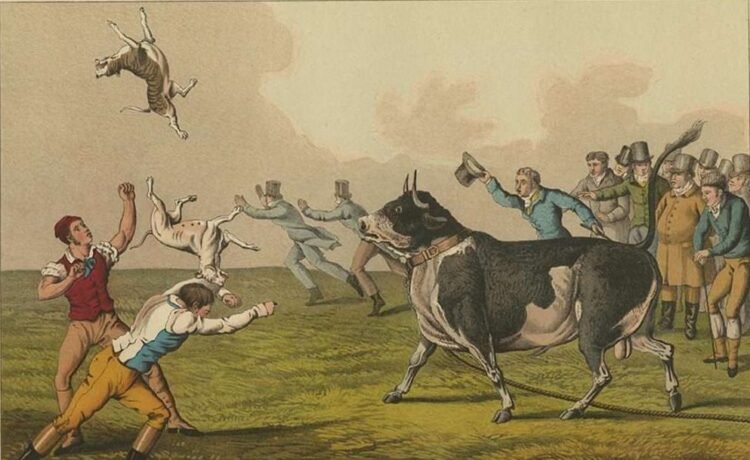
 Before they were suppressed in the late nineteenth century, some New Yorkers enjoyed cruel sports which would not be tolerated today. Among these were “baiting” which pitted specially trained dogs against various other species. This was a favorite of both city and country dwellers, and was sometimes even more popular than cockfighting.
Before they were suppressed in the late nineteenth century, some New Yorkers enjoyed cruel sports which would not be tolerated today. Among these were “baiting” which pitted specially trained dogs against various other species. This was a favorite of both city and country dwellers, and was sometimes even more popular than cockfighting.
Although baiting came from the Romams who matched every species of bird and beast they could, it continued in England where there is evidence that even before Tudor times (1485-1603) Britons practicing cockfighting as well as bull, badger and bear baiting.

 “Baiting’s Golden Age began under Henry VIII [1491-1547], who divided his leisure time between the Westminster cockpit and the Bankside Bear Garden, which he built in the early 1500s,” says historian Don Atyeo in his Blood and Guts: Violence in Sports (1979)
“Baiting’s Golden Age began under Henry VIII [1491-1547], who divided his leisure time between the Westminster cockpit and the Bankside Bear Garden, which he built in the early 1500s,” says historian Don Atyeo in his Blood and Guts: Violence in Sports (1979)
“A special herd of [brown] bears was kept outside London to meet the demands of the capitals’ sportsmen; in the provinces town councils promoted official bear baits to keep their electors happy. By this time bears had grown scarce in England, so baits were usually halted before the bear was actually killed.
“The careers of champion bears were followed… closely. Sackerson, Blind Robin, Tom of Lincoln and Ned of Canterbury all gained considerable reputations as champion fights, and Old Nell, a famous Middlewich bear, was regularly taken to an alehouse after a bait and stood rounds of beer by her admirers.”

 The Puritans opposed these “sports” to little effect and baiting flourished at the Restoration in 1660. John Evelyn (1620-1706) wrote in his diary on June 16th, 1670:
The Puritans opposed these “sports” to little effect and baiting flourished at the Restoration in 1660. John Evelyn (1620-1706) wrote in his diary on June 16th, 1670:
“I went with some friends to the bear-garden, where was cock-fighting, dog-fighting, bear and bull baiting, it being a famous day for all these butcherly sports, or rather barbarous cruelties. The bulls did exceedingly well, but the Irish wolf-dog exceeded, which was a tall greyhound, a stately creature indeed, who beat a cruel mastiff. One of the bulls tossed a dog full into a lady’s lap, as she sat in one of the boxes at a considerable height from the arena. Two poor dogs were killed, and so all ended with the ape on horseback, and I most heartily weary of the rude and dirty pastime, which I had not seen, I think, in twenty years before.”
“A pack of dogs, often numbering as many as six at a time, would be set on a chained bull with the object their ‘pinning’ the animal by its nose or dewlap and forcing it to its knees,” Atyeo relates.
“A good fighting bull could toss a dog thirty feet into the air with a shake of its horns and open its belly like a zipper…. Gradually the muzzles of these dogs became flattened through selective breeding – to give them an even better grip – producing what is now known as the ‘bulldog’.”
Other animals were also baited, those these were more of a novelty act than a serious sport. They included horses, apes, lions, and more regularly, badgers.

 Small terriers were bred for “ratting” which flourished throughout the nineteenth century, especially in London and the city of New York. “A terrier was placed in a pit with a given number of rats and set to work, the spectators betting on how many the dog could kill within a given period,” says Atyeo.
Small terriers were bred for “ratting” which flourished throughout the nineteenth century, especially in London and the city of New York. “A terrier was placed in a pit with a given number of rats and set to work, the spectators betting on how many the dog could kill within a given period,” says Atyeo.
“Rules were strict: broken backs did not count as a kill unless the rat was unable to crawl outside a circle the size of a dinner plate; a dog was disqualified if it left more than a specified number of rats alive, or if it leaped from the pit.”
“Sometimes by way of variety a man would enter the pit with his hands tied behind his back to compete against a dog, biting the rats terrier-style with his teeth. On other occasions the pit was roofed over with chicken wire and cats were substituted for rats.”
Most baiting was officially outlawed in England by the Cruelty to Animals Act in 1835, but ratting continued:
“Despite the appalling odor by the sewer rats which turned the pits into reeking cesspools, ratting attracted a large and faithful following. By the mid-1800s there were were more than seventy permanent rat pits in London alone, and the sporting journal Bell’s Life was packed with advertisements such as ‘Ratting!! Ratting!! Ratting!! There will be an extraordinary number of rats destroyed on Monday evening at J. Ferriman’s Graham Arms, Graham Street, City Road’ and ‘Ratting every Saturday. Best of wines and spirits.”
Baiting, together with a variety other brutal Northern European carnival traditions like “cat-in-a-barrel” and “pulling-the-goose” – both particular popular with the New Netherland Dutch – were practiced in the American colonies.
Baiting occurred on Bayard’s Hill and on The Bowery in New York. For example, in 1763 a large crowd witnessed a bear baited to death the De Lancey Arms in New York. John Cornell, near St. George’s Ferry, Staten Island, advertised in 1774 that there would be a bull baited on “Tower Hill” at three o’clock every Thursday afternoon during the season.
“All my brother and me thought of at that time was this rough, exciting sort of business, dog fighting, rooster fighting, bear baiting, rat baiting, and all the other hellish baiting we could find, and we used to hunt for it everywhere, from the lowest to the highest, just to see all there was in New York,” Howell Gardener, brother of bare knuckle boxer Orville “Awful” Gardner recalled about the 1840s.
In 1852, in West Troy (now Watervliet in Albany County, NY) the following was reported:
“We understand that a real live ‘bear fight’ was to have taken place in West Troy on Wednesday last. The parties concerned were pretty much all from this city [Troy]. The combatants consisted of a bear and three or four bull terriers. But it appears that the participants in this intellectual and refined amusement were sadly disappointed.
“The ‘bar’ would not fight! Upon being placed in the ring, he laid down upon his back and let the dogs tear him to pieces. After the poor bear had been nearly killed, the dogs were called off and the brute brought away.

 “Quite a sum of money was bet upon the result. Such proceedings as this, in a respectable community, is disgraceful to all concerned, were they no more than spectators of the cruel and inhuman amusement, if amusement it can be called; and deeper is the stain when men of pretended respectability and some standing in society, give countenance to it by their presence.
“Quite a sum of money was bet upon the result. Such proceedings as this, in a respectable community, is disgraceful to all concerned, were they no more than spectators of the cruel and inhuman amusement, if amusement it can be called; and deeper is the stain when men of pretended respectability and some standing in society, give countenance to it by their presence.
“We supposed that such things as bear, dog, cock or man fights, had been pretty much done away with in this vicinity, but it seems there are some among us yet, whose brutish propensities cannot be sated except with the shedding of blood. At any rate, fighting between either animals or men, for money, has a very injurious effect, and should not be tolerated under any circumstances. It brings the man down to the level of the brute, and destroys all the dignity belonging to him.”
In the end Americans preferred shooting their animals to tormenting them in pits, and bear baiting and its relatives generally died out by 1900. Cock and dog fighting however remained a favorite of all classes, and continues to this day in underground locations, mostly in the South.
Read more about the history of sports in New York.
Illustrations, from above: “Bull Baiting” by J. Clark, 1820 (London); Bear-baiting in the 14th century (British Library); badger-baiting in London, ca. 1823; “Terrier Dog Major ratting,” by an unknown 19th century artist (Major was known to have killed 100 rats in 8 minutes, 58 seconds); “A Gander-Pull” illustration of a live goose pulling in 19th-century West Virginia by Frederic Remington; and a bear and bull fight in New Orleans in 1853.









Recent Comments